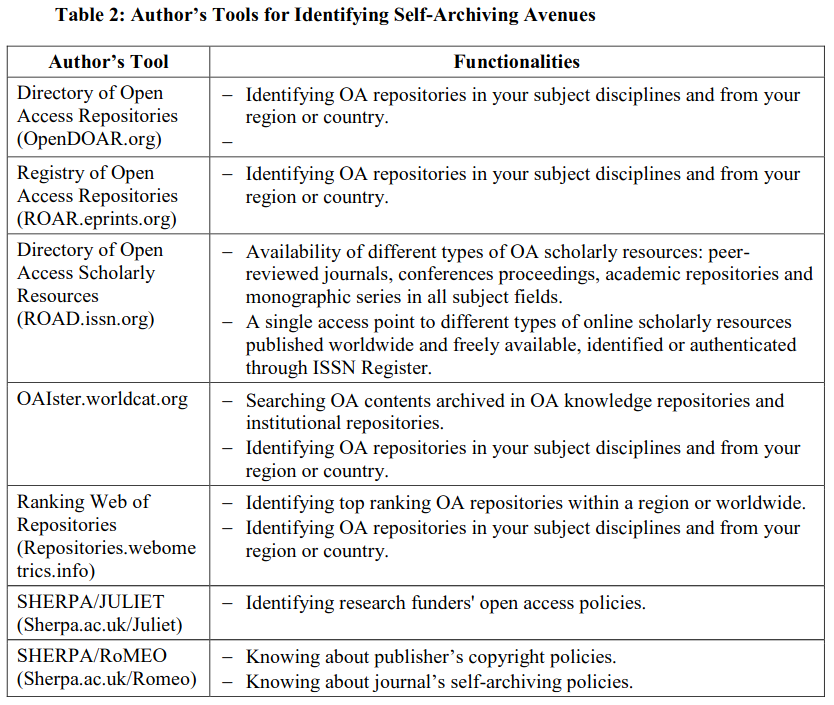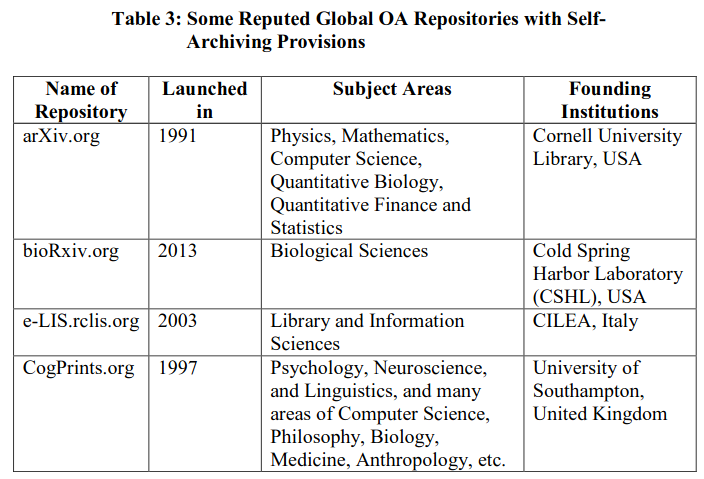2.2 HOW AND WHERE TO DEPOSIT
The authors of scholarly works can decide whether to make their published, un-published or forthcoming research publications globally available and accessible through Green OA channels. Various tools are available to scientific researchers while taking their self-archiving decision. Some of the tools or aids to authors’ publishing decisions are described in Table 2. All of these tools are freely available and accessible globally. Mentioned portals have become very useful to academic authors as many detailed information on every listed OA repository is made available and accessible. These tools also have global coverage, covering repositories available from every corner of the world. Authors may take their self-archiving decision based on subjective judgement after consulting some of these tools. OpenDOAR.org, launched in 2006 jointly by University of Nottingham in the U.K. and Lund University in Sweden, is a global listing of open access archives and repositories. It becomes an authoritative tool for identifying operational OA repositories and their administrative details. The Registry of Open Access Repositories (ROAR) is another global listing of open access archives and repositories, although some of the records in this listing may be outdated or not up-to-date. OpenDOAR and ROAR also indicate software used for building respective OA repository. Majority of repositories are using DSpace and EPrints software. These software use similar self-archiving work flow, thus provide similar self-archiving experience to the researchers. Both the software are available as free and open source software (FOSS). They also support web crawlers or metadata harvesters to obtain metadata information from OA repositories and store in a union catalogue of records of OA resources. OAIster is one such metadata harvester-cum-union catalogue for OA repositories and archives. OAIster21, launched in 2002 by the University of Michigan Libraries, is a union catalogue of OA resources obtained from OA collections, which was built by harvesting from worldwide OA repositories and digital archives using the Open Archives Initiative Protocol for Metadata Harvesting (OAI-PMH). This union catalogue is presently hosted at WorldCat.org database of the Online Computer Library Center, Inc. (OCLC). SHERPA/JULIET and SHERPA/RoMEO, maintained by University of Nottingham, are excellent source for identifying research funders' open access policies, knowing about publisher’s copyright policies and journal’s self-archiving policies. These two sources help authors in identifying what to deposit – Preprint, Post-print, or Publisher’s version of their publications. A preprint is a draft version of a scientific paper that has not yet been published in a peer-reviewed scientific journal. A post-print is a digital draft of a journal article after it has been peer reviewed. Jointly, post-prints and preprints are called eprints. On the other hand, a publisher version is the official version in PDF with unaltered page layout and pagination. The researchers also have freedom to choose file formats for self-archiving of their publications. Available file formats are PDF, HTML, XML, MS-Word and LaTex. Usually publisher version is available in PDF or HTML. Table 3 shows an indicative list of disciplinary OA repositories available to researchers worldwide. In addition to their own institutional repositories and national-level repositories, authors may choose to self-archive their publications at an appropriate disciplinary OA repository. Availability of your publications in multiple portals makes sure your publications are visible, reachable and accessible to global multidisciplinary researchers’ communities.


